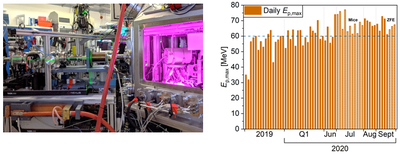Institute of Radiation Physics
The Institute of Radiation Physics at the Helmholtz-Zentrum Dresden-Rossendorf conducts research in the areas of matter and health. It operates the ELBE center for high power radiation sources where advanced accelerator research, laser plasma as well as superconducting radio-frequency technology based, meet user facility support for outstanding basic and applied research with electron beam driven pulsed high field THz, IR-FEL, positron, neutron, and gamma sources.
Leading research in accelerator and high power laser physics is complemented by development in novel detection and measurement techniques. These range from XFEL probing of ultra-fast dynamics of high energy density states of matter over positron based materials research to applications. In order to investigate the interaction of high power lasers with matter the Titanium:Sapphire laser Draco is operated which gives the unique opportunity to either observe interaction of laser pulses with matter or couple the laser to the electron accelerator ELBE. The use of the latest high power GPU computing technology assures real-time handling of big data and sets world-wide standards for open source simulation tools for complex systems.
Within the cancer research program the institute conducts research in laser development, particle beam transport and analysis as well as in the study of the radiobiological effectiveness of ultra-short high dose rate particle bunches. In a close collaboration with the Institute for Radiooncology – OncoRay it supports the medical physics section in the development and construction of hardware components, e.g. for PET, prompt gamma-ray imaging, and prompt gamma-ray timing for online in-vivo dosimetry and in the determination of secondary neutron fluxes in proton therapy.
By focusing the high power laser Draco onto carefully prepared and online diagnosed solid targets, nanosecond proton bunches with energies up to 80 MeV could recently be accelerated with exceptional stability and control. In order to achieve clinical relevant ion energies, the underlying acceleration mechanisms are further developed. In parallel, the novel energy efficient high power laser PEnELOPE is developed.
Together with the OnCOOPtics group at OncoRay, the usability in cancer therapy is explored. Compact beam lines for protons with pulsed magnets are designed and set up taking advantage of the time structure of the ion beam. Furthermore, radiobiological effects of this high dose rate radiation are studied in in vitro cell experiments as well as in vivo mouse models.

left: Picture of the pulsed magnet proton beam transport following the plasma acceleration inside a large vacuum chamber. © HZDR
right: Stability of proton acceleration over irradiation campaigns in 2020. © HZDR
Spectral and spatial shaping of laser-driven proton beams using a pulsed high-field magnet beamline,
F.-E. Brack et al. Scientific Reports 10, 9118 (2020)
Detection Systems for Range Monitoring in Proton Therapy: Needs and Challenges
G. Pausch et al. Nuclear Instruments and Methods A 954, 161227 (2020)
Feasibility of proton FLASH effect tested by zebrafish embryo irradiation
E. Beyreuther et al. Radiother Oncol 139, 46 (2019)
A Monte Carlo based radiation response model to assess variability of clinical RBE in proton therapy
J. Eulitz et al. Physics in Medicine and Biology 64, 225020 (2019)
Processing of prompt gamma-ray timing data for proton range measurements at a clinical beam delivery
T. Werner et al. Physics in Medicine and Biology 64, 105023 (2019)
All-optical structuring of laser-driven proton beam profiles,
L. Obst-Huebl et al Nature Communications 9, 5292 (2018)
Isolated Proton Bunch Acceleration by a Peta-Watt Laser Pulse,
P. Hilz et al Nature Communications 9, 423 (2018)
A Bayesian Approach for Measurements of Stray Neutrons at Proton Therapy Facilities: Quantifying Neutron Dose Uncertainty
M. Dommert et al. Radiation Protection Dosimetry 180, 319 (2018)
A light-weight compact proton gantry design with a novel dose delivery system for broad-energetic laser-accelerated beams,
U. Masood et al. Phys. Med. Biol. 62, 5531 (2017)
An optimized small animal tumour model for experimentation with low energy protons
E. Beyreuther et al. PLoS One 12, e0177428 (2017)


